One of the most important destinations in India, Madhya Pradesh is known to be the heart of the country. Out of the many attractions, the forts and palaces in Madhya Pradesh are simply irresistible. The list of must-visit destination in Madhya Pradesh is endless and includes myriad of its charms.
From ancient monuments, pilgrimages, forests to hill stations, there are many places to be explored. But the historical and cultural legacy of the state is very well preserved and portrayed in the splendid forts and palaces.
Most of these architectural gems are in a wonderful state and must be explored. The blog enlists the most popular forts and palaces in Madhya Pradesh.
Mansingh Palace, Gwalior
Commissioned by Tomar King Man Singh, between 1486 and 1516, the Mansingh Palace in Gwalior is a wonderful specimen of early Hindu architecture. The four-storied structure definitely counts as one of the must-visit destinations in Madhya Pradesh.
The outer walls have tigers, elephants, peacock and crocodiles in ornamented blue, green and yellow. Whereas on the other hand, the interiors are quite simple yet attractive. The jali and tile work are quite attractive.

There are 2 open courts enveloped by apartments on 2 levels. Below the ground, are 2 storeys for hot weather, linked by ‘speaking tubes’ encrusted into the walls. They were used by the Mughals as prison cells. It is also known as the Chit Mandir. Read More
- Entry Fee: Indian/foreigner: INR 5/100
- Camera: INR 25
- Timings: Dawn to Dusk
- Things to do: Enjoy the time travel to history, shopping at the local markets
- Best Time to visit: October to March
Jai Vilas Palace, Gwalior
A royal residence of the Scindia family, the Jai Vilas Palace was built between 1872 A.D. and 1874 A.D. by Maharaja Jayajirao. The entry gate of the palace is on its west side and a part of it has been converted into a museum.
Built-in different architectural styles of the Corinthian and Tuscan, this beautiful palace today is maintained by the state government. Jai vilas palace is placed on a small tower and thus you can savor lovely views of the surroundings.

The palace’s museum comprises of stunning cut-glass furniture, 1 ladies-only swimming pool with a boat and stuffed tigers. The grand dining room has a rail model with a silver train that carried after-dinner cigars and brandy around the table.
- Entry Fee: Indian/foreigner ₹140/800
- Camera/video Fee: ₹100/150
- Timings: 10:00 AM- 04.45 PM (April to September) and 10:00 AM- 04.30 PM (October – March). Wednesday Closed
- Things to do: Enjoy the evening tours, enjoy high tea, cherish music and dance performances
- Best Time to visit: October to March
Plan your Tour to Gwalior with these tastefully crafted packages
Jahangir Mahal, Orchha
A fine specimen of medieval Islamic style of architecture, the Jahangir Mahal in Orchha was erected during the 17th century. King Vir Singh Deo constructed this popular palace in Madhya Pradesh in the honor of Mughal Emperor Jahangir. The palace enjoys various other names such as Orchha Palace, Citadel of Jahangir, Mahal-e-Jahangir Orchha and Jahangir Citadel.
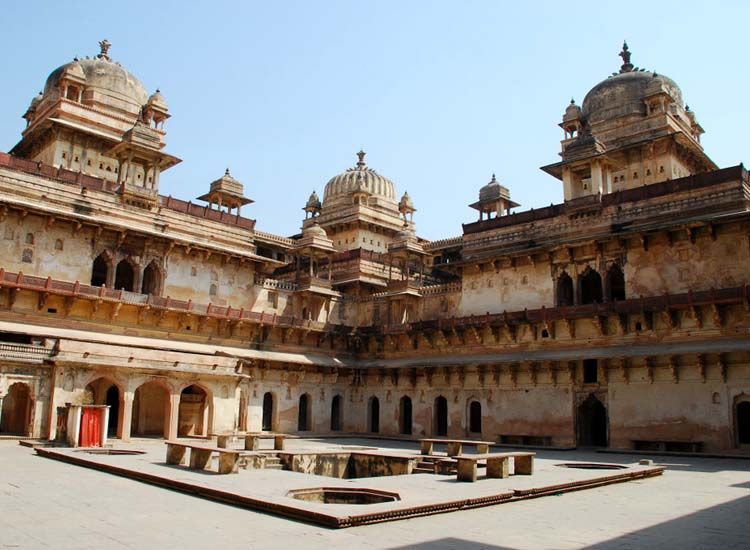
Along with as many as 100 rooms, the palace also has hanging balconies and expansive courtyards. The entry is from the east side and it also has 2 stone elephant statues with a hanging bell. The palace is adorned with a number of walkways and steep staircases. Behind the palace, there are camel stables and a lush ground with a number of monuments.
- Entry Fee: Indian/foreigner ₹05/30
- Timings: 8:00 am to 5:00 pm
- Things to do: Explore Orchha Fort, visit Raja Mahal, excursion to the Chaturbhuj and Ram Raja Temple
- Best Time to visit: October to March
Jahaz Mahal, Mandu
The Jahaz Mahal is located on the northern side of Munj Talao (Tank) in the royal Mandu complex. Also known as the water palace, the edifice has 2 halls with special-valued ceilings.
The walls are made up of marble and have several medals in yellow and blue along with inscriptions. Though in ruins, it still looks captivating and exploring the palace is one of the must things to do in Madhya Pradesh.

Although not much is known about the time of its construction but it is believed that the fort was built after the Khalji era. Also, it is supposed that the palace used to offer an intimate place to the royal couples.
Another assumption is that the palace is one of the luxury retreats of the Sultan of Malwa. The palace comprises of small baolis (water wells) in the courtyard. The whole complex is connected to it through a pathway.
- Entry Fee: Indian/foreigner ₹05/100
- Video fee: ₹25
- Timings: 6:00 am to 7:00 pm
- Things to do: Get insights about history, enjoy photography and visit nearby attractions
- Best Time to visit: October to March
Sheesh Mahal, Orchha
Converted into a heritage hotel, the Sheesh Mahal is a stunning palace. Constructed in the 18thcentury by Udait Singh as his personal rest house, the palace is a must-visit while on family vacations. Looking like an extension of the Jahangir Mahal, this 2-storied structure has a number of winding stairways. These stairways lead to the thickly-walled smaller rooms, a few bigger rooms and some courtyards.

Placed westwards of the Jahangir Mahal, Sheesh Mahal or the Palace of Mirrors was inherited by the state government after independence. It is exactly placed between the Raj Mahal and the Jahangir Mahal, at the end of the courtyard. The structure has a coat of whitewash.
- Entry Fee: N/A
- Timings: N/A
- Things to do: Enjoy a comfortable stay, visit nearby forts and palaces
- Best Time to visit: October to March
Hindola Mahal, Mandu
Translated as Swing Palace, the Hindola Mahal is named so because of its sloping side walls. Construction of the T-shaped structure began in 1425 C.E. but was completed at the end of the 15th century. The palace is a part of the royal complex in Mandu.
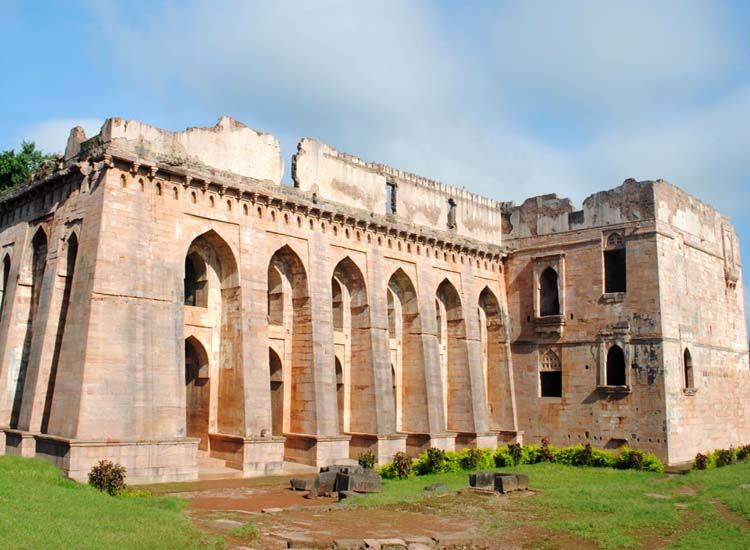
Hindola Mahal consists of a main hall with 6 arched openings on both its sides. Above the openings, are windows that have delicate tracery work so that air and light can pass through them easily. The roof of the hall is vaulted though slightly ruined now. Anybody planning holidays in Madhya Pradesh should include this splendid edifice in his itinerary.
- Entry Fee: Indian/foreigner ₹05/100
- Video Camera: INR 25
- Timings: 6:00 AM – 7:00 PM
- Things to do: Explore various other forts, Know about the various nearby baolis and legends associated with it
- Best Time to visit: July to March
Mandu is also considered one of the finest monsoon destinations in India with rain bringing out the best of this pastoral retreat. If you are planning to go on a holiday in the month or July, August or September in India, do check out our post on Best Places to Visit in India in Monsoons.
Rajwada Palace, Indore
The Rajwada Palace in Indore was constructed in 1747 A.D by Malhar Rao Holkar, the founder of Holkar Dynasty. Also known as the Holkar Palace, the 7-storied palace is one of the oldest structures in Indore.
Located in Khajuri Bazaar, the well-maintained palace has a garden in front with a statue of Queen Ahilya Bai, an artificial waterfall, and fountains. Portraying an amalgam of Maratha, Mughal and French architectures, the palace has 3 lower floors in stone and upper floors in wood.
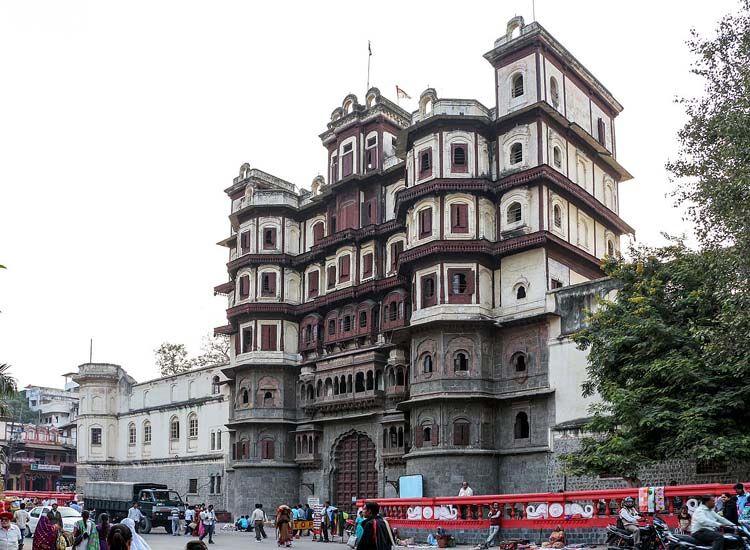
Though the palace was damaged thrice due to fire but was reconstructed with same method and structure in 2006. Today, the rectangular structure has beautiful outlined windows, huge courtyard, Ganesh Hall, a Gallery room, balconies with Mughal embellishments and more.
- Entry Fee: INR 10 per person
- Timings: 10:00 AM – 5:00 PM (Closed on Monday)
- Things to do: Soak-in the beauty of the palace, sneak peek into history
- Best Time to visit: October to March
Lal Bagh Palace, Indore
Built by the rulers of the Holkar dynasty, the Lal Bagh Palace was erected between 1886 and 1921 by Maharaja Shivaji Rao Holkar. The construction of this one of the finest structures took place in three phases.
Spread in a garden of 28 hectares, the palace’s gates seems to be a replica of the Buckingham Palace of the United Kingdom. It used to be the venue of lavish royal receptions hosted by the Holkars.

The beautiful palace has influences of European styles including a Palladian queen’s bedroom, baroque and rococo dining rooms. An elegant Renaissance sitting room with ragged sofas and an English library that has chairs with leather armrests add to its charm.
While on the ground floor, there are prehistoric artifacts, the first floor has a coin collection dating back to Muslim era. The mighty palace has other amazing displays too. October to March are the best months to explore the palace making it one of the ideal winter destinations in India.
- Entry Fee: INR 10 per person
- Timings: 10:00 AM- 05:00 PM (Tuesday – Sunday)
- Things to do: Photography
- Best Time to visit: October to March
Plan your Tour to Indore with these tastefully crafted packages
Gwalior fort, Gwalior
One of the most popular attractions in Madhya Pradesh, the massive Gwalior fort offers fabulous views. A stunning medieval architecture, the fort has several splendid structures in its premises. Adorned with attractions like Jain temples, Saas Bahu temple, Teli ka Mandir, Suraj Kund, Hathi Pol, Gujari Mahal etc., the fort presents a sight to behold.
Sound and light show held in the premises is a sheer delight. This one definitely counts as one of the finest forts and palaces in Madhya Pradesh.

The Gwalior fort was commissioned by Rajput Tomar ruler Man Singh (525 AD). It had been in the hands of the Mughals too who used it as a prison. Lying on the top of a 3-km long plateau, the palace has stunning exterior adorned with beautiful turquoise tiles. Today a part of it is the famed private Scindia School, founded in 1897.
- Entry Fee: Indian/children/foreigner ₹75/40/250
- Timings: 06:00 AM–05:30 PM
- Things to do: Attend the light and sound show, delight in a matchless experience, photography
- Best Time to visit: October to March
Bandhavgarh Fort, Umaria
Known to be a 10th-century structure, the Bandhavgarh Fort even finds its reference in ancient books like the Shiva Purana and Narad-Pancharatra. Believing the Indian mythology, one gets to know that the fort was gifted by Lord Rama to his younger brother Lakshmana.
The reign of the fort passed into the hands of several dynasties such as the Maghas, the Vakatakas and the Sengars. The Kalchuris and the Baghels also got the privileged to rule over the fort. The fort was deserted back in 1935.

Lying within the premises of Bandhavgarh National Park, the majestic edifice is placed on a hilltop. Perched at an altitude of 811 m, the forts offers fascinating views of the wildlife reserve. Tourists flock here in the month of December on the occasion of Kabir Mela and also to enjoy jungle safari.
- Entry Fee: N/A
- Timings: Sunrise to Sunset
- Things to do: Jungle Safari at the Bandhavgarh National Park, Explore attractions within the park like Shesh Shaiya, Three Cave Point, Badi Gufa etc.
- Best Time to visit: October to April
Bandhavgarh is considered to be one of the finest places for wildlife safaris in India. If you are planning to go on a wildlife tour in India do check out our post on Top 10 Wildlife Destinations in India or explore our wildlife in India section and wildlife tour packages.
Madan Mahal Fort, Jabalpur
Erected way back in 1116 by Gond ruler Raja Madan Shah, Madan Mahal Fort is positioned above a craggy hilltop. The fort was used as a watchtower due to its location. One can savor wonderful views from this popular forts and palaces in Madhya Pradesh. Built as a pleasure palace for the ruler, today the fort is managed by the Archaeological Survey of India.
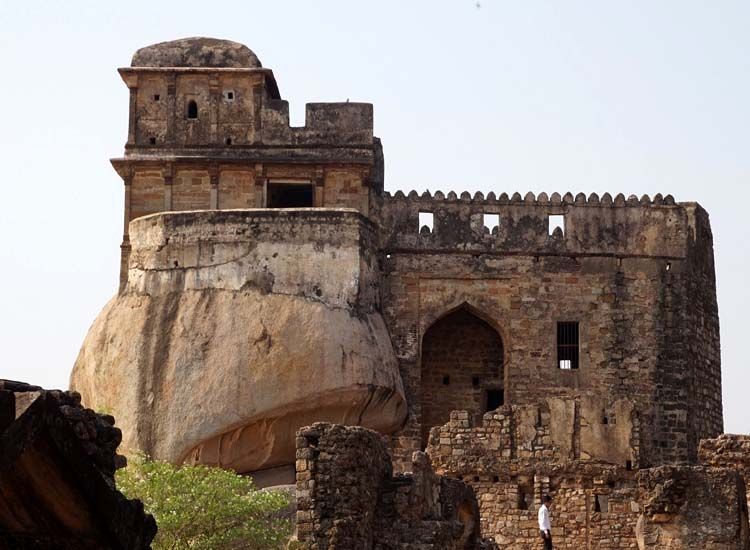
On the way to the fort, you come across a number of structures including shrines. Sangram Sagar and Bajnamath are two of the popular ones. These were founded by another popular Gond ruler, Sangram Singh, between 1480 and 1540. Be careful of the black-faced langurs in the premises. The fort also has a well, a number of stables, rooms, ancient scripts, secret passages, corridors and more.
- Entry Fee: Nil
- Timings: 07:00 am – 06:30 pm (open on all days)
- Things to do: Explore nearby attractions like the Dhaundhar waterfall, Bhedaghat, Balancing rock, Rani Durgavati Museum etc.
- Best Time to visit: October to March
Asirgarh Fort, Burhanpur
Popularly known as the ‘Key to the Deccan’, Asirgarh fort is around 20 km away from the main town. The route to the fort passes via the Saputara Ranges, joining the Narmada and Tapti River Valleys. Though slightly in ruins, the fort still has a wonderful charm. Commissioned by Asa Ahir of the Ahir dynasty, the fort is also known as Asa Ahir Garh.
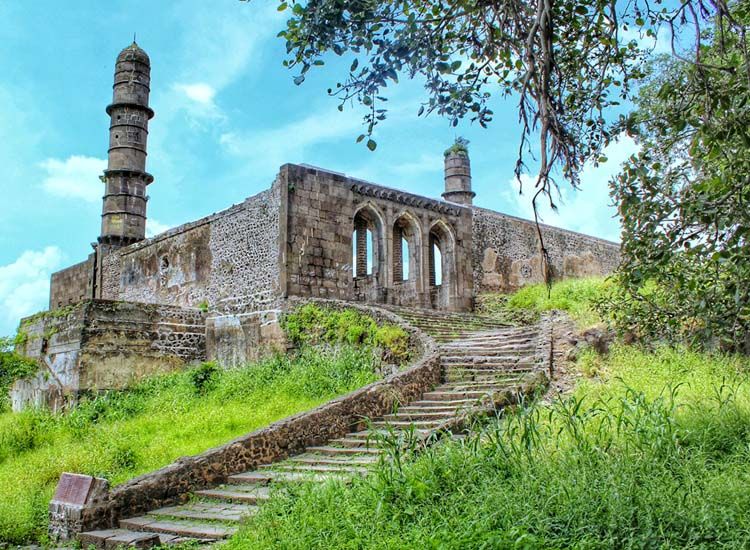
As far as the architecture is concerned, it has influences from Mughal, Islamic, Persian, Turkish and Indian styles of architecture. Stones, lime-stones and lead were used for the construction of this architectural wonder.
The fort has 3 man-made ponds that were used for water supply. Inside the fort’s premises is a ruined mosque with splendid minarets, called Asir Masjid. There is a Lord Shiva temple too. After the British rule, the fort was abandoned but still is counted as one of the top tourist attractions in Madhya Pradesh.
- Entry Fee: Nil
- Timings: 10:00 am to 5:00 pm. Last entry is usually around 30 minutes to 1 hour before closing.
- Things to do: Get insights about the history of the fort, Unveil the mysteries associated with the fort
- Best Time to visit: October to March
Chanderi Fort, Chanderi
Built during the 11th century, the Chanderi fort is surrounded by hills, lakes, and forests. The fort is placed towards the South-west of the Betwa River atop a hill, at a height of 71 m. Monuments that were owned by the Malwa Sultans and the Bundela Rajputs are nestled around the fort.
Placed on the borders of Bundelkhand and Malwa, Chanderi even finds a mention in the great Hindu epic, Mahabharata. It was then ruled by Shishupal.
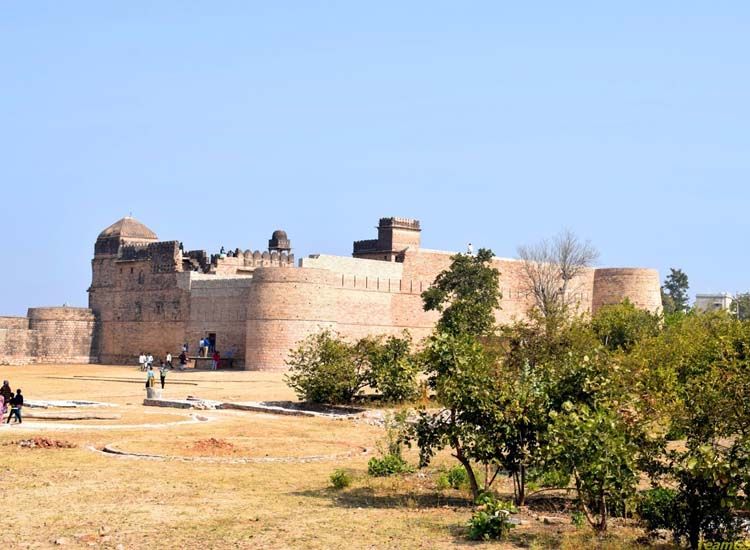
The massive fort features a huge gate that was famously known as the ‘Khooni Darwaza’. During their rule, the Muslim kings commissioned the fortification walls. The fort also has an inquisitive gateway towards its southwest, called Katti Ghatti, made via hillsides.
- Entry Fee: Nil
- Timings: 6:30 am – 6:00 pm
- Things to do: Excursion to nearby attractions, shopping of Cahnderi Sarees from local markets, Visit the Idgah mosque, marvel at the Koshak Mahal, explore the Badal Mahal Gate
- Best Time to visit: October to March
Dhar Fort, Dhar
Placed on a rectangular-shaped hilltop, Dhar Fort is made up of red stone. Situated 3 km away from the Dhar town, the fort is a strong one. The Dhar fort’s main entrance is towards the west. The diary of Mughal Emperor states that the fort was commissioned by 1344 A.D. by Mohammad Tughlak.
It was later on captured by the rulers of Pawar Dynasty in 1732 A.D. After this, there were changes as per Samrangan Sutradhar.

Some of the main attractions of this fort are Kharbuja Mahal and Sheesh Mahal. This fort is also the birthplace of Peshwa Bajirao II. A visit to the fort makes the trip to Madhya Pradesh memorable one.
- Entry Fees: Nil
- Timings: Dawn to Dusk
- Things to do: Explore the nearby places to visit, Get insights about the history, visit the Kharbuja Mahal and Sheesh Mahal
- Best Time to visit: October to March
All these forts and palaces in Madhya Pradesh represent the glorious past of the state very well and are a must-visit at least once.
Related Post

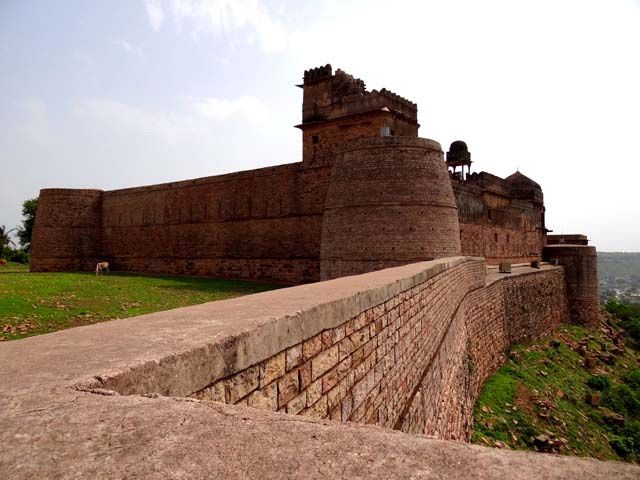
 3 Days Tour to Gwalior
3 Days Tour to Gwalior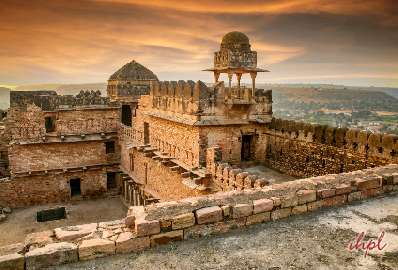 3 Days Tour to Gwalior and Chanderi
3 Days Tour to Gwalior and Chanderi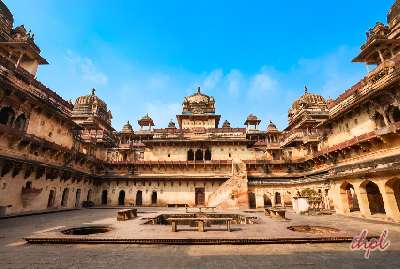 Gwalior Orchha Khajuraho Tour
Gwalior Orchha Khajuraho Tour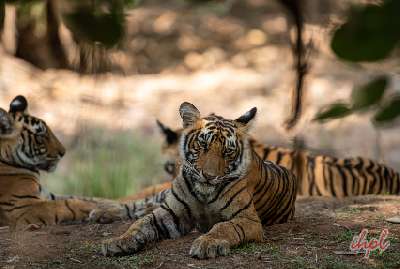 Splendors of Madhya Pradesh
Splendors of Madhya Pradesh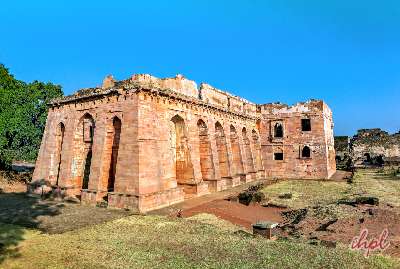 Mandu Omkareshwar Tour
Mandu Omkareshwar Tour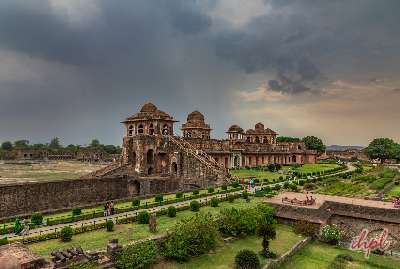 Short Escape to Mandu
Short Escape to Mandu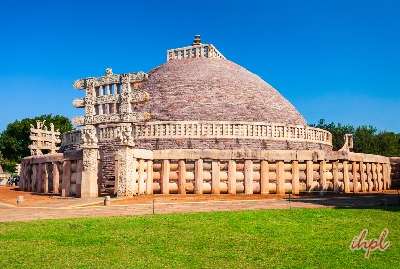 Madhya Pradesh Classical Tour
Madhya Pradesh Classical Tour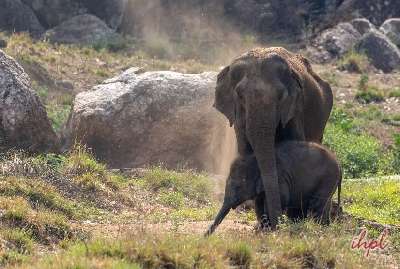 Madhya Pradesh Wildlife Tour
Madhya Pradesh Wildlife Tour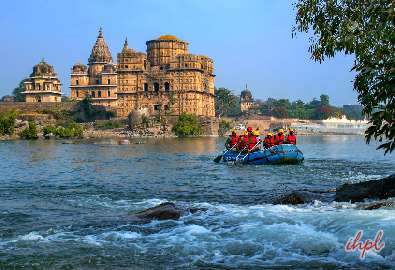 2 Days Tour to Orchha
2 Days Tour to Orchha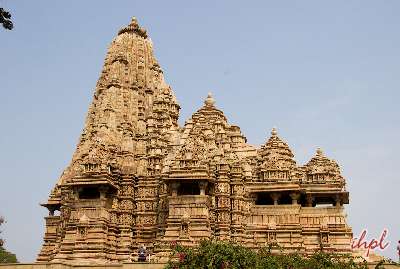 Orchha Khajuraho Tour
Orchha Khajuraho Tour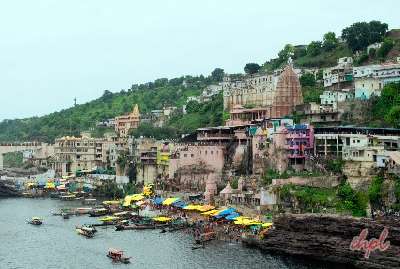 Madhya Pradesh Spiritual Tour
Madhya Pradesh Spiritual Tour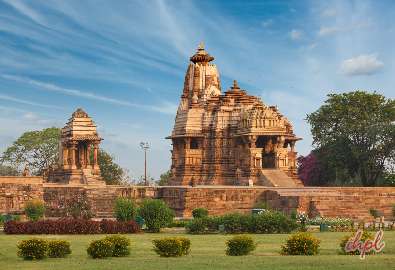 Madhya Pradesh Heritage Tour
Madhya Pradesh Heritage Tour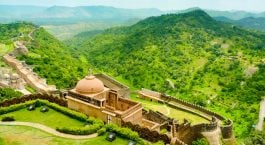
very nice blog and palace
Hi Pooja,
Thank you for your kind words! Keep on following our blogs for more such posts in the future.
Thanks for sharing this informative and comprehensive blog. This is very interesting article. The pictures are really beautiful and the way you explained about the places to visit.
Hey Chitra
Thanks for your kind words! Keep on following our blogs for more such informative posts in the future.